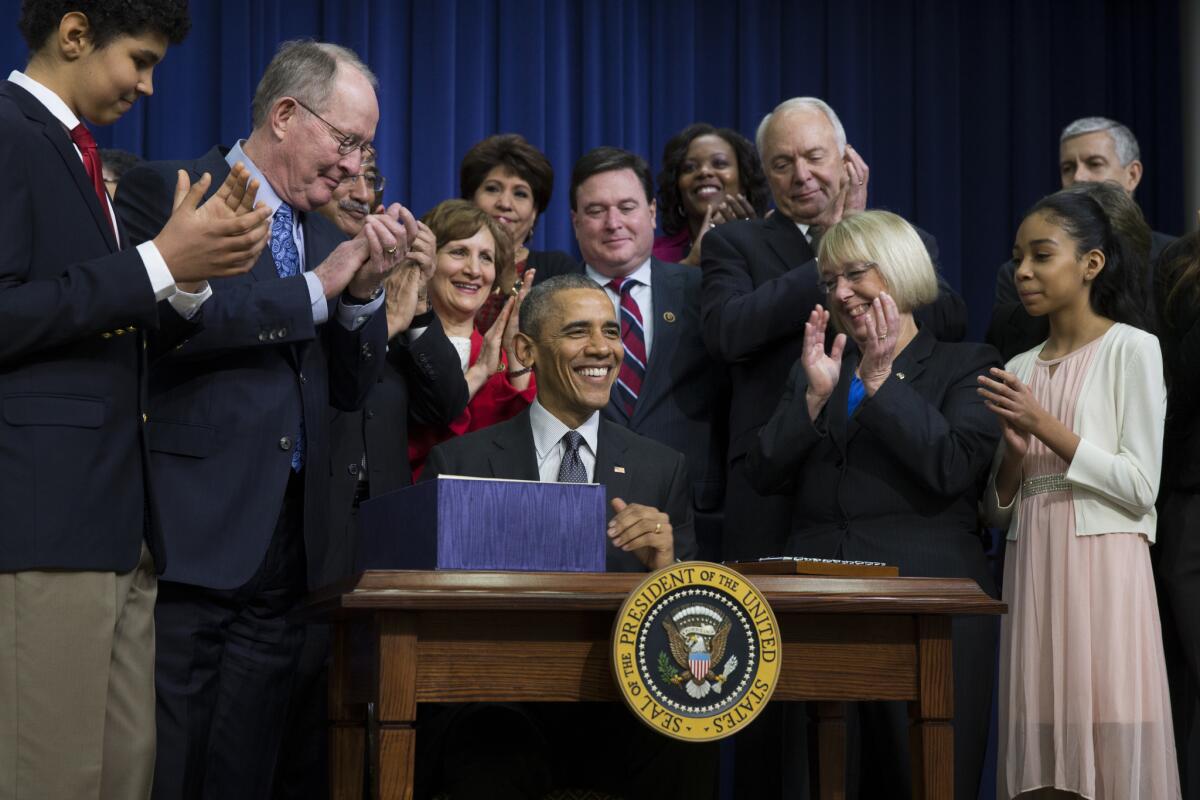Editorial: Every Student Succeeds Act fails too many students

President Obama speaks before signing the “Every Student Succeeds Act,” a rewrite of the landmark “No Child Left Behind” education-reform law, on Thursday in Washington. The new law will change the way teachers are evaluated and how the poorest performing schools are pushed to improve.
Is anyone mourning the No Child Left Behind Act? Its clumsy regulations and harshly punitive measures against low-performing schools left many, many students behind and worsened education in multiple communities around the nation. But the Every Student Succeeds Act, which President Obama signed into law Thursday morning to replace it, is even more of a lie. This measure doesn’t even pretend to create situations in which large numbers of academically struggling students will succeed, let alone all or even most of them.
As satisfying as it is to see No Child Left Behind go away at long last — and even more to be rid of the Obama administration’s clumsy waiver program for states seeking a way out of the law’s requirements — this new act is a compromise that benefits pretty much everyone but the students most in need of improved schools. Although it requires annual testing to continue for third- through eighth-graders and once for high-schoolers, it abandons federal curriculum and performance standards in favor of greater state autonomy. As a result, it leaves entirely squishy what sorts of educational standards states are expected to set, and what steps even the worst schools will have to take to show they’re improving. It merely calls for states to make some effort to improve the lowest performers — those in the bottom 5% and the high schools where more than a third of students drop out. The many schools that are simply mediocre are completely off the hook.
Many were the constituencies that came to detest No Child Left Behind, and often for good reasons. Teachers and their unions hated rigid improvement requirements that punished even hard-working educators and their schools, as well as Obama administration rules that forced states to use standardized test scores as a major factor in measuring a teacher’s worth if they wanted to win a waiver from the law (California refused to go along with that, and remained under the law’s thumb). Middle-class parents whose children already attended schools that were fairly good or better resented the relentless focus on fill-in-the-bubble tests; education in science, the arts, writing and critical thinking suffered. And conservatives believed the federal interference in curriculum and standards impinged on states’ rights.
The final straw in the eyes of many people was the Obama administration’s push to get states to adopt the Common Core academic standards. The standards and the related curriculum were unconventional and off-putting to some educators, and the abrupt implementation disrupted school progress and alienated parents when the first test results came out low.
The biggest winners in the law’s demise, though, are the politicians who crafted its replacement, which they can cite as an example of the compromises they’re capable of achieving. Both sides get something to bring home to their constituents: a reduced federal role to please Republicans, a backing away from most teacher accountability rules for Democrats aligned with the teachers’ unions.
Their concerns were legitimate, but make no mistake — this isn’t a win-win situation. The losers are disadvantaged students stuck in mediocre or worse public schools. The Every Student Succeeds Act will make it hard to even identify the schools that need intervention, by allowing states to rate success by such vague measures as school climate, parent involvement and teacher engagement. Those are all fine things for schools to focus on, but if they don’t result in better-educated students, how is this success?
The Every Student Succeeds Act hands almost all the authority back to the states, so the only hope for improving schools at this point is that states will step into the void with helpful, meaningful improvement plans for their underperforming institutions. The harsh disciplinary measurements under No Child Left Behind are well left behind; the firings and turnarounds were often unfair and, in the end, not very effective. But a new law should be more than a repudiation of the old; it should provide a blueprint for improving educational outcomes. The federal government spends billions of dollars on low-income schools in an effort to level the playing field and improve social mobility through public education. It has a right and a responsibility to ensure that it’s getting its money’s worth for the billions of dollars it invests in low-income schools.
Follow the Opinion section on Twitter @latimesopinion and Facebook
More to Read
A cure for the common opinion
Get thought-provoking perspectives with our weekly newsletter.
You may occasionally receive promotional content from the Los Angeles Times.










